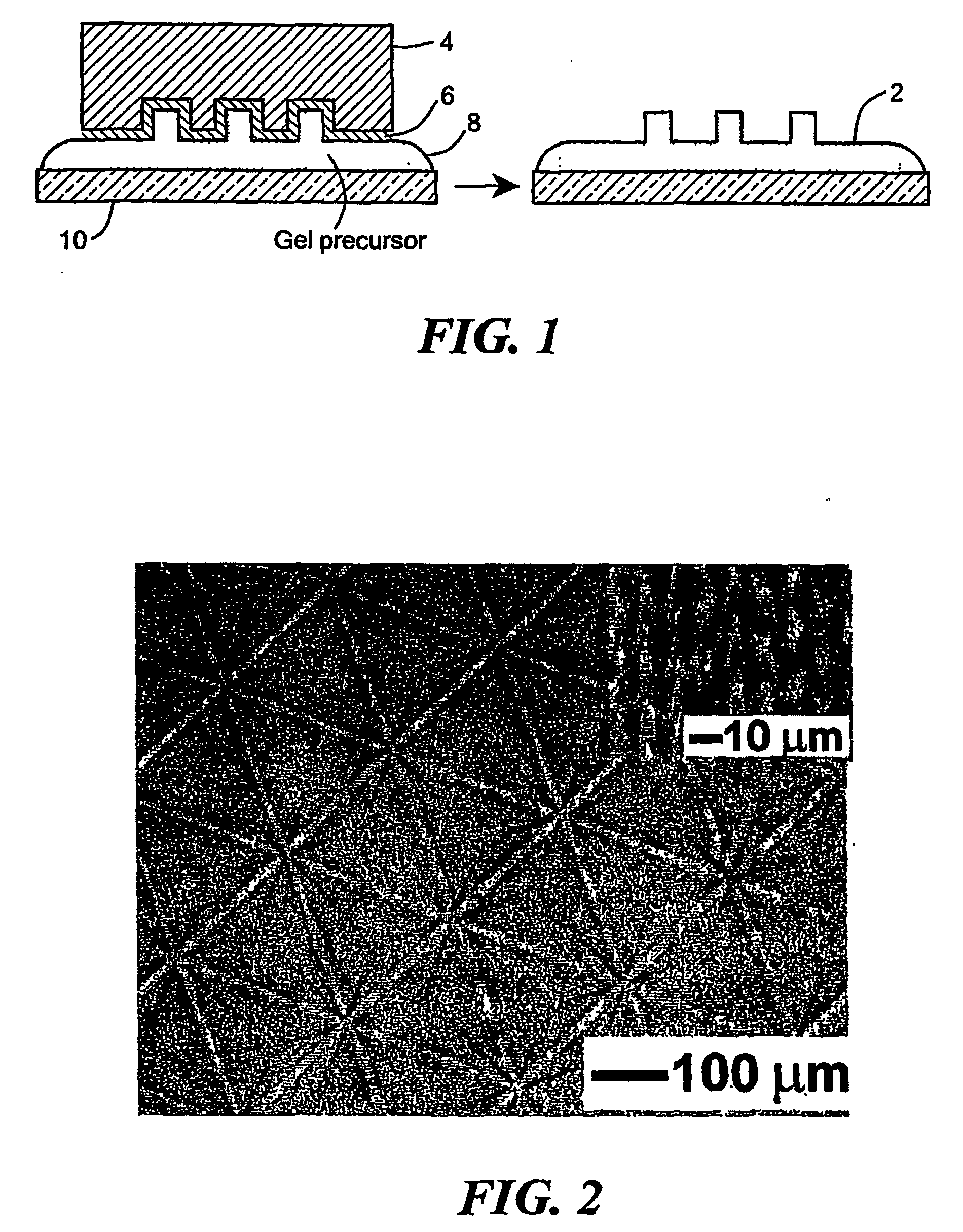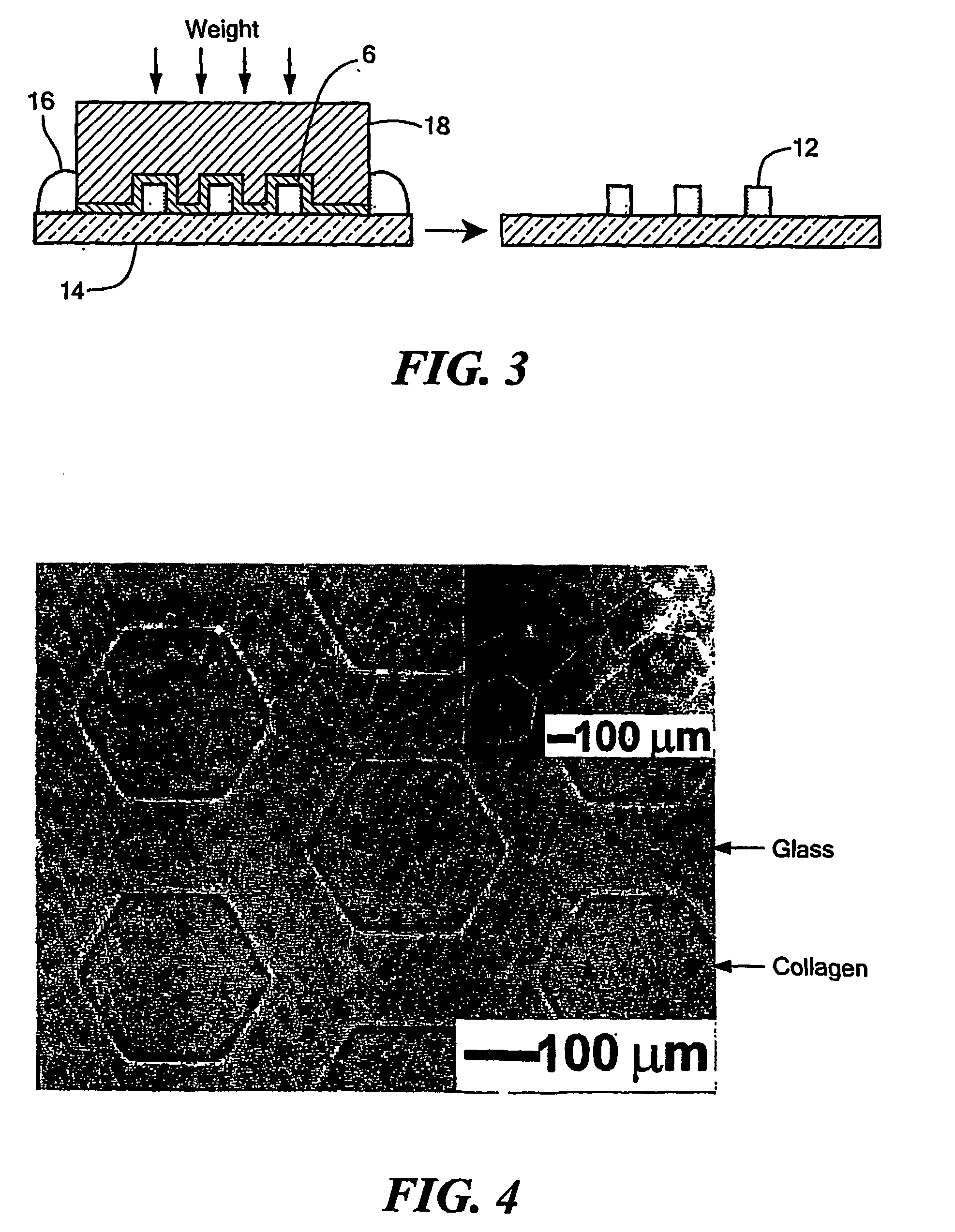Three-dimensional gels that have microscale features
a three-dimensional gel and microscale technology, applied in the field of microfabrication, can solve the problems of inability to encapsulate a suspension of biological materials, inability to represent in vitro models of vascular or other biological tissues, and inability to achieve in vitro models of three-dimensional biological gels or extracellular matrixes, etc., to achieve the effect of eliminating non-specific binding
- Summary
- Abstract
- Description
- Claims
- Application Information
AI Technical Summary
Benefits of technology
Problems solved by technology
Method used
Image
Examples
example i
[0077]FIG. 14 shows a scheme for enhancing transport or, flow within the hydrogels by a gravity induced pressure difference. The scheme shows that many materials in a solution may be transported into and out of cavities via diffusion or flow through the encasing hydrogel, although flow is much more rapid than diffusion. The scheme is based on the fabricated hydrogel cavities fabricated as described above. In this example, a pressure difference causes an aqueous solution to flow through the hydrogel and its cavities. The velocity of flow through a sample of 1 mm by 1 cm by 1 cm is about 50 μm per minute. The flow is due to tilting of the hydrogel structure. The tilt is at an angle of about 30°.
[0078] Introduction of a pressure difference can make a solution flow through, for example, the collagen-based hydrogel and the cavities. The flow enhances an exchange of materials between the cavities and the surrounding hydrogel. A fluorescently labeled immunoglobulin IgG of about 150 kDa is...
example ii
[0080]FIG. 16 is a scheme for mechanically entangling and / or chemically bonding a first micropatterned hydrogel 70 and a second hydrogel 68 using a destabilizer as described above. The bonded and / or entangled hydrogels are supported on a substrate 72. The scheme involves treating the surface of the first micropatterned hydrogel with a 0.7 M urea in PBS solution for about five minutes. The second hydrogel surface is treated with 1.7 M urea in PBS solution for about ten minutes. The hydrogels are then interfaced. A PBS solution is flowed through the interfaced hydrogels for about three hours. The adherence strength among the hydrogels can be measured by a suitable substrate peel method.
example iii
[0081]FIGS. 17 and 18 are optical micrographs of different hydrogel networks comprising two micropatterned hydrogel structures. These hydrogels may or may not be mechanically entangled and / or chemically bonded together. The individual micropatterned hydrogel structures can be fabricated by any of the schemes, methods or embodiments described above. The individual hydrogels can also be any suitable type for a particular network or a specific application of that network. For example, the micropatterned hydrogels of these networks can be protein and / or sugar-based. In these networks, the features of the individual hydrogels are aligned to allow fluid flow. The networks received flows of bovine and / or human vascular endothelial cells, which attached to the walls of the network. These cells can be seen in both FIGS. 17 and 18.
[0082] The invention provides a convenient method for fabricating the hydrogel structures and networks described above. For example, the invention provides a metho...
PUM
| Property | Measurement | Unit |
|---|---|---|
| temperature | aaaaa | aaaaa |
| temperature | aaaaa | aaaaa |
| Temperature | aaaaa | aaaaa |
Abstract
Description
Claims
Application Information
 Login to View More
Login to View More - R&D
- Intellectual Property
- Life Sciences
- Materials
- Tech Scout
- Unparalleled Data Quality
- Higher Quality Content
- 60% Fewer Hallucinations
Browse by: Latest US Patents, China's latest patents, Technical Efficacy Thesaurus, Application Domain, Technology Topic, Popular Technical Reports.
© 2025 PatSnap. All rights reserved.Legal|Privacy policy|Modern Slavery Act Transparency Statement|Sitemap|About US| Contact US: help@patsnap.com



